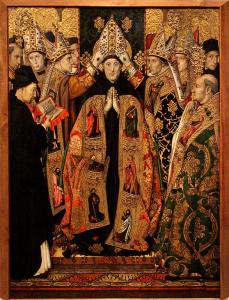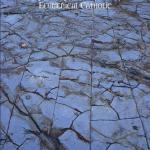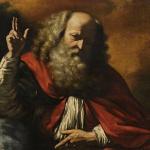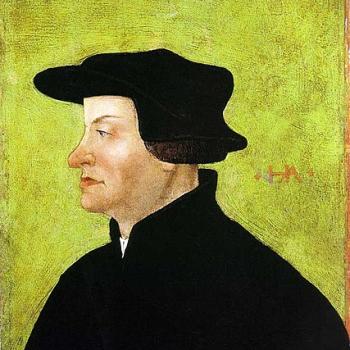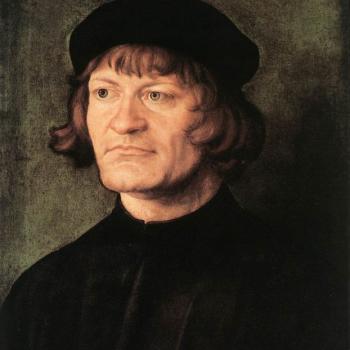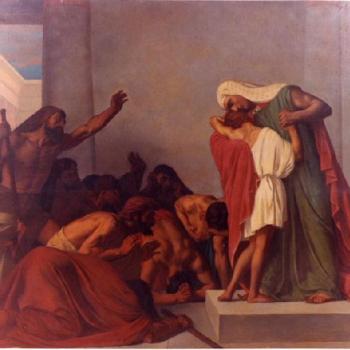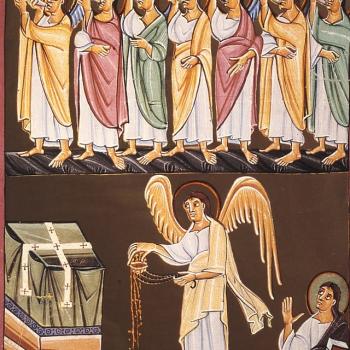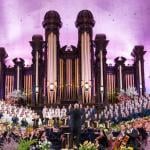+ St. Augustine’s Enthusiastic Advocacy of Relics
Calvinist apologist Matt Hedges wrote the article, “Did the Church Fathers Teach the Veneration and Worship of Images?” (Soli Deo Gloria Apologetics, 7-28-22).
*****
Matt brings up Catholic and Orthodox apologetic use of Letter 360 written by St. Basil of Caesarea [known as the Great] (330-379). He notes that many scholars consider it spurious. That’s fine. I will assume that it is (and this probably is the case). The same saint, however, wrote in his work, The Holy Spirit:
[T]he honour paid to the image passes on to the prototype. . . . the image is by reason of imitation, . . . in works of art the likeness is dependent on the form . . . (chapter 18, section 45)
The Council of Trent reflected this reasoning:
Further, the images of Christ, of the Virgin Mother of God, and of other saints are to be kept and preserved, in places of worship especially; and to them due honor and veneration is to be given, not because it is believed that there is in them anything divine or any power for which they are revered or in the sense that something is sought from them, or that a blind trust is put in images as once was done by the Gentiles who placed their hope in idols [cf. Ps 135:15-17], but because the honor that is shown them is referred to the original subjects they represent. Thus, through these images that we kiss and before which we kneel and uncover our heads, we are adoring Christ and venerating the saints whose likeness these images bear. That is what was defined by the decrees of the councils, especially the Second Council of Nicaea, against the opponents of images. (25th session: 1563: On the Invocation, Veneration, and Relics of Saints, and on Sacred Images; but I have modified the text to conform to the 2012 translation of the 43rd edition of Denzinger’s Compendium of Creeds: #1823, p. 430. One of the editors and translators is a personal friend of mine: Dr. Robert Fastiggi)
Matt then claimed that “the Fathers . . . didn’t venerate images, but rather condemned them.” He submits that St. Augustine was one of these, and cites him four times, alongside St. Clement of Alexandria (twice) and Lactantius. That’s not exactly an overwhelming presentation of patristic evidence, commensurate with Matt’s grand, sweeping claim. He incorrectly cites his Exposition of Psalm 113 (it should be 115). There, St. Augustine is condemning the worship of plaster or stone. All Catholics join him in this, and it’s not a condemnation of all veneration of images, but rather, of gross idolatry. Matt cites part of this motif from Augustine:
“For they have mouths, and speak not: they have eyes, and see not” [Psalm 113:5] . . . Do we pray unto them, because through them we pray to God? [echoing Basil above] This is the chief cause of this insane profanity, that the figure resembling the living person, which induces men to worship it, has more influence in the minds of these miserable persons, than the evident fact that it is not living, so that it ought to be despised by the living. (5, 7; my bolded italics, as throughout my Augustine citations)
In context, Augustine nails down his valid (and very biblical and Catholic) point:
Employ not then the hands of men, to create a false Deity out of that metal which a true God has created; nay, a false man, whom you may worship for a true God…. (4)
A man then moves himself, that he may frighten away a living beast from his own god; and yet worships that god who cannot move himself, as if he were powerful, from whom he drove away one better than the object of his worship….Even the dead surpasses a deity who neither lives nor has lived…. (5)
[B]y considering these works themselves as deities, and worshipping them as such, they serve the creature more than the Creator, who is blessed forever…. (6)
Trent, cited above, made precisely the same point: Catholics honor and venerate [not worship!] images “not because it is believed that there is in them anything divine or any power for which they are revered or in the sense that something is sought from them . . .”
Matt then cites one sentence from Augustine’s Harmony of the Gospels, Book I, Chapter 10 (16). Unfortunately, he leaves a mistaken impression of Augustine’s meaning in context, so that it sounds iconoclastic. In fact, Augustine’s point was that gullible folks believed that Jesus wrote material dedicated to Paul and Peter, not by consulting the Bible, but rather, from “painted walls.” Here are the two sections with the relevant contextual information included:
15. Nay more, as by divine judgment, some of those who either believe, or wish to have it believed, that Christ wrote matter of that description, have even wandered so far into error as to allege that these same books bore on their front, in the form of epistolary superscription, a designation addressed to Peter and Paul. And it is quite possible that either the enemies of the name of Christ, or certain parties who thought that they might impart to this kind of execrable arts the weight of authority drawn from so glorious a name, may have written things of that nature under the name of Christ and the apostles. But in such most deceitful audacity they have been so utterly blinded as simply to have made themselves fitting objects for laughter, even with young people who as yet know Christian literature only in boyish fashion, and rank merely in the grade of readers.
16. For when they made up their minds to represent Christ to have written in such strain as that to His disciples, they bethought themselves of those of His followers who might best be taken for the persons to whom Christ might most readily be believed to have written, as the individuals who had kept by Him on the most familiar terms of friendship. And so Peter and Paul occurred to them, I believe, just because in many places they chanced to see these two apostles represented in pictures as both in company with Him. For Rome, in a specially honourable and solemn manner, commends the merits of Peter and of Paul, for this reason among others, namely, that they suffered [martyrdom] on the same day. Thus to fall most completely into error was the due desert of men who sought for Christ and His apostles not in the holy writings, but on painted walls. Neither is it to be wondered at, that these fiction-limners were misled by the painters. For throughout the whole period during which Christ lived in our mortal flesh in fellowship with His disciples, Paul had never become His disciple. . . . How, then, is it possible that Christ could have written those books which they wish to have it believed that He did write before His death, and which were addressed to Peter and Paul, as those among His disciples who had been most intimate with Him, seeing that up to that date Paul had not yet become a disciple of His at all? (the lone sentence that Matt cited is italicized)
We see, then, that this has nothing whatsoever to do with a supposed condemnation of all veneration of images. This is shoddy research at best. Matt then cites St. Augustine’s Letter 55 to Januarius (11):
The first commandment, in which we are forbidden to worship any likeness of God made by human contrivance, we are to understand as referring to the Father: this prohibition being made, not because God has no image, but because no image of Him but that One which is the same with Himself, ought to be worshiped; and this One not in His stead, but along with Him.
This one is self-refuting, in terms of Matt’s purpose to establish St. Augustine as an iconoclast. His point is not to oppose veneration of all images whatsoever, but rather, images of God the Father in particular, other than Jesus, “the image of the invisible God” (Col 1:15, RSV). This might be broadly interpreted to include something like a crucifix, which many Calvinists absurdly oppose as an idol as well.
So that’s three down and one to go. Matt offers one more proof of Augustine’s supposed iconoclasm.
“Why have I said this? Please consider carefully the chief point I’m making. We had started to deal with the apparently better educated pagans — because the less educated are the ones who do the things about which these do not wish to be taken to task — so with the better educated ones, since they say to us, “You people also have your adorers of columns, and sometimes even of pictures.” And would to God that we didn’t have them, and may the Lord grant that we don’t go on having them! But all the same, this is not what the Church teaches you. I mean, which priest of theirs ever climbed into a pulpit and from there commanded the people not to adore idols, in the way that we, in Christ, publicly preach against the adoration of columns or of the stones of buildings in holy places, or even of pictures? On the contrary indeed, it was their very priests who used to turn to the idols and offer them victims for their congregations, and would still like to do so now.” (Sermon 198)
This doesn’t appear to be included in the 38-volume Schaff collection. But note that he is not condemning veneration. He’s condemning the same thing that he blasted in Exposition of Psalm 115 above: worshipers of stone and other material objects, as if they were gods or God (rank idolatry). We know from his language: “adorers / adore idols / adorations of columns . . . stones . . . pictures.”
As Matt well knows, the Catholic Church condemns these things in no uncertain terms as well. But Calvinists seem constitutionally unable to distinguish veneration of an image as a representation of a saint, and idolatrous adoration of material things. For them, they all must be the same thing (idolatry) and couldn’t possibly be otherwise. Not so for Augustine. He agrees with St. Basil’s and Trent’s point of representation:
But in regard to pictures and statues, and other works of this kind, which are intended as representations of things, nobody makes a mistake, especially if they are executed by skilled artists, but every one, as soon as he sees the likenesses, recognizes the things they are likenesses of. (On Christian Doctrine, Book II, chapter 25, section 39)
St. Augustine also had a robust and thoroughly Catholic understanding of relics (including their veneration):
Then Thou by a vision made known to Your renowned bishop the spot where lay the bodies of Gervasius and Protasius, the martyrs . . . when they were revealed and dug up and with due honour transferred to the Ambrosian Basilica, not only they who were troubled with unclean spirits (the devils confessing themselves) were healed, but a certain man also, who had been blind many years, a well-known citizen of that city, having asked and been told the reason of the people’s tumultuous joy, rushed forth, asking his guide to lead him there. Arrived there, he begged to be permitted to touch with his handkerchief the bier of Your saints, whose death is precious in Your sight. When he had done this, and put it to his eyes, they were immediately opened. (Confessions, Book 9, 7, 16; my italicized bolding)
The reliquaries of the martyrs and the churches of the apostles bear witness to this; for in the sack of the city they were open sanctuary for all who fled to them, whether Christian or Pagan. To their very threshold the blood-thirsty enemy raged; there his murderous fury owned a limit. (City of God, Book 1, 1)
Certainly we honor their reliquaries, as the memorials of holy men of God who strove for the truth . . . (City of God, Book 8, 27; my italicized bolding)
For were I to be silent of all others, and to record exclusively the miracles of healing which were wrought in the district of Calama and of Hippo by means of [the relics of] this martyr— I mean the most glorious Stephen— they would fill many volumes; and yet all even of these could not be collected, but only those of which narratives have been written for public recital. (City of God, Book 22, 8)
For even now miracles are wrought in the name of Christ, whether by His sacraments or by the prayers or relics of His saints . . . The miracle which was wrought at Milan when I was there, and by which a blind man was restored to sight, could come to the knowledge of many; . . . the occurrence was witnessed by an immense concourse of people that had gathered to the bodies of the martyrs Protasius and Gervasius, . . . By virtue of these remains the darkness of that blind man was scattered, and he saw the light of day. (City of God, Book 22, 8)
Now he had received from a friend of his own some holy earth brought from Jerusalem, where Christ, having been buried, rose again the third day. . . . Hesperius asked us to visit him, and we did so. When he had related all the circumstances, he begged that the earth might be buried somewhere, and that the spot should be made a place of prayer where Christians might assemble for the worship of God. We made no objection: it was done as he desired. There was in that neighborhood a young countryman who was paralytic, who, when he heard of this, begged his parents to take him without delay to that holy place. When he had been brought there, he prayed, and immediately went away on his own feet perfectly cured. (City of God, Book 22, 8)
When the bishop Projectus was bringing the relics of the most glorious martyr Stephen to the waters of Tibilis, a great concourse of people came to meet him at the shrine. There a blind woman entreated that she might be led to the bishop who was carrying the relics. He gave her the flowers he was carrying. She took them, applied them to her eyes, and immediately saw. . . . Lucillus bishop of Sinita, in the neighborhood of the colonial town of Hippo, was carrying in procession some relics of the same martyr, which had been deposited in the castle of Sinita. A fistula under which he had long labored, and which his private physician was watching an opportunity to cut, was suddenly cured by the mere carrying of that sacred fardel, — at least, afterwards there was no trace of it in his body. Eucharius, a Spanish priest, residing at Calama, was for a long time a sufferer from stone. By the relics of the same martyr, which the bishop Possidius brought him, he was cured. Afterwards the same priest, sinking under another disease, was lying dead, and already they were binding his hands. By the succor of the same martyr he was raised to life, the priest’s cloak having been brought from the oratory and laid upon the corpse. . . . A religious female, who lived at Caspalium, a neighboring estate, when she was so ill as to be despaired of, had her dress brought to this shrine [of St. Stephen], but before it was brought back she had gone. However, her parents wrapped her corpse in the dress, and, her breath returning, she became quite well. At Hippo a Syrian called Bassus was praying at the relics of the same martyr for his daughter, who was dangerously ill. He too had brought her dress with him to the shrine. But as he prayed, behold, his servants ran from the house to tell him she was dead. His friends, however, intercepted them, and forbade them to tell him, lest he should bewail her in public. And when he had returned to his house, which was already ringing with the lamentations of his family, and had thrown on his daughter’s body the dress he was carrying, she was restored to life. There, too, the son of a man, Irenæus, one of our tax-gatherers, took ill and died. And while his body was lying lifeless, and the last rites were being prepared, amidst the weeping and mourning of all, one of the friends who were consoling the father suggested that the body should be anointed with the oil of the same martyr. It was done, and he revived. Likewise Eleusinus, a man of tribunitian rank among us, laid his infant son, who had died, on the shrine of the martyr, which is in the suburb where he lived, and, after prayer, which he poured out there with many tears, he took up his child alive. . . . It is not yet two years since these relics were first brought to Hippo-regius, and though many of the miracles which have been wrought by it have not, as I have the most certain means of knowing, been recorded, those which have been published amount to almost seventy at the hour at which I write. But at Calama, where these relics have been for a longer time, and where more of the miracles were narrated for public information, there are incomparably more. . . . At Uzali, too, a colony near Utica, many signal miracles were, to my knowledge, wrought by the same martyr, whose relics had found a place there by direction of the bishop Evodius, long before we had them at Hippo. (City of God, Book 22, 8)
These ladies carry with them relics of the most blessed and glorious martyr Stephen: your Holiness knows how to give due honour to these, as we have done. (Epistle 212: to Quintilianus [423]; my italicized bolding)
St. Augustine, preaching over “the relics of the first and most blessed martyr, Stephen” (1), taught that honor or veneration of a martyr is worshiping Christ:
[W]e haven’t built an altar in this place to Stephen, but an altar to God from Stephen’s relics. (1)
Let the martyr Stephen be honored here; but in his honor let the one who crowned Stephen be worshiped. (3) (Sermon 318: On the Martyr Stephen; dated 425)
This solemn occasion, my brothers and sisters, is being held to the honor of God, on account of a servant of God. When a servant, after all is being honored properly, he is honored in the name of his master. (Sermon 335K: On the Anniversary of the Burial of a Bishop, 1)
When we pay honor to the martyrs, we are honoring the friends of Christ. (Sermon 332: On the Birthday of Some Martyrs, 1)
In Sermon 316 (4), Augustine states: “Saul, for whom it was not enough for Stephen to have been killed, which is something we gladly recollect, because we venerate him . . .” In the Sermon fragment 335G, he proclaims: “let us honor the martyrs.” He also notes: “So let us celebrate Saint Stephen’s birthday, and honor him with due reverence. We have celebrated the Lord’s birthday; let us also celebrate his servant’s” (Sermon 317: On the Martyr Stephen, 6).
St. Augustine wants such honor and veneration to be accompanied by pious imitation of the saints and martyrs:
[T]o honor and not imitate them is nothing more or less than false flattery. (Sermon 325: On the Birthday of the Twenty Martyrs)
It’s easy enough to celebrate in honor of a martyr; the great thing is to imitate the martyr’s faith and patience. (Sermon 311: On the Birthday of the Martyr Cyprian, 1)
The book, Augustine Through the Ages: An Encyclopedia (general editor, Allan D. Fitzgerald, O.S.A., Grand Rapids, Michigan: Eerdmans, 1999), referred to many of the above sermons and a certain change of attitude and belief on Augustine’s part:
The arrival in 416 of the relics of Stephen, . . . had the effect of substantially altering Augustine’s attitude toward the veneration of relics and the problem of miracles worked by these. . . . [I]n 424, with long years of episcopal ministry behind him and moved by the new, stimulating climate of enthusiasm, Augustine . . . has a chapel (memoria) built in Hippo to house the ashes of Stephen and devotes a substantial series of sermons (314-20) to the praise of the holy martyr. . . . In addition, the multiplication of miracles caused by these relics leads him to see to the compiling of detailed and systematic official reports . . . for use as a crushing proof against the stubborn unbelief of pagans [City of God, Book 22, 8]. (p. 162)
***
Matt Hedges replied to this on 8-3-22. I decided to let him have the last word (all debates have to end at some point), and in fairness I provide the link to his response. But it did bring home to me again the correctness of my opinion that debates about the views of the Church fathers between Catholics and Protestants are very unfruitful and futile, and accomplish next-to-nothing (“ships passing in the night” is very descriptive of what they almost always descend to). Very few of us in debates on the fathers are patristics scholars or even any sort of experts on them.
It’s much more constructive — and enjoyable –, in my opinion, to do comparative exegesis. What does the Bible teach on thus-and-so? Both sides agree that the Bible is inspired, infallible revelation. It’s something objective to discuss. My next reply to Matt will be of that nature.
***
More exchanges on my Facebook page:
*
***
Practical Matters: Perhaps some of my 4,000+ free online articles (the most comprehensive “one-stop” Catholic apologetics site) or fifty books have helped you (by God’s grace) to decide to become Catholic or to return to the Church, or better understand some doctrines and why we believe them.
Summary: Calvinist apologist Matt Hedges claimed that St. Basil the Great & St. Augustine opposed the veneration of images and communion of saints. I demonstrate quite otherwise.


